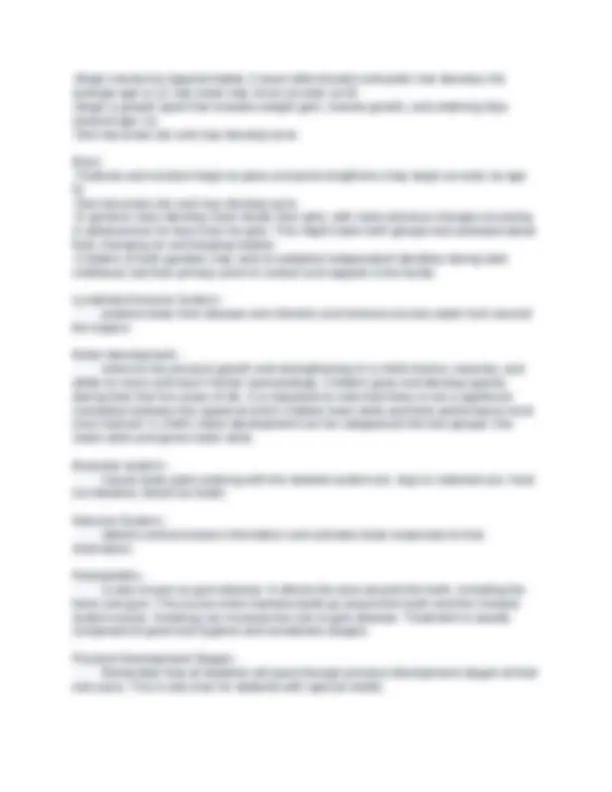





Study with the several resources on Docsity

Earn points by helping other students or get them with a premium plan


Prepare for your exams
Study with the several resources on Docsity

Earn points to download
Earn points by helping other students or get them with a premium plan
Community
Ask the community for help and clear up your study doubts
Discover the best universities in your country according to Docsity users
Free resources
Download our free guides on studying techniques, anxiety management strategies, and thesis advice from Docsity tutors
CSET Health Science PART 1 study system
Typology: Study notes
1 / 6

This page cannot be seen from the preview
Don't miss anything!




Adolescence - Girls: -Reach mature pubic, armpit, and leg hair patterns (13-14) -Complete breast development (12-18) -Growth spurt slows (16) Boys: -Begin growing pubic, armpit, leg, chest, and facial hair (around age 12) -Voice changes (13) -Begin a growth spurt that includes weight gain, muscle growth, and broadening shoulders (13) -Experience nocturnal emissions (13-17) -Reach mature pubic, armpit, leg, chest, and facial hair patterns (17-18) -Genitals reach adult size and shape (17-18) -Growth spurt slows (18) Because adolescence brings on rapid development, both boys and girls may feel awkward and become sensitive and self-conscious about their bodies, especially if they develop slower, faster, or even differently than their peers. Same-sex peer groups become important in early adolescence, and in mid- adolescence, teens show an interest in romantic relationships. This culminates in late adolescence, where teens begin to feel the need to assert a sexual identity. Teenagers are on a quest to establish their own independence and identity, so they often lash out at authority figures, including parents and teachers. American Public Health Association (APHA) - publishes science-backed periodicals, offers professional development courses, and has a broad-based member community whose power can influence federal policy to improve public health. American School Health Association (ASHA) - is a multidisciplinary organization made up of school administrators, counselors, dieticians, nutritionists, health educators, physical educators, and social workers. It works to lead efforts that prioritize school-based approaches, providing lifelong health and community support to the whole child. California Healthy Kids Survey (CHKS) - is an anonymous, confidential survey that analyzes student wellness, school safety, and student resilience, taken by students in grades five, seven, nine, and eleven. The data allows schools and communities to gain a better understanding of student
health risks and behaviors, school and community climate, protective factors, and school violence. California Penal Code 11165.7 - all school staff, teachers, aides, administrators, before- and after-school providers, Head Start teachers, and day camp instructors are considered "mandated reporters." Cardiovascular / Circulatory System - transports material (ex: oxygen) throughout the body CDC Global School-based Student Health Survey - was developed by the World Health Organization (WHO) with technical assistance from the CDC. This survey is given to students ages 13-17 worldwide. The purpose of this survey is to track trends in the prevalence of health behaviors and protective factors by country and then help countries develop priorities and establish necessary health programs. Coordinated School Health (CSH) - The purpose of CSH programs is to increase students' health and academic achievement in schools though a support network involving families, community members, and the school collaborating to address and meet the needs of children. There are eight components, which include: -Safe and healthy school environment -Health education -Physical education -Nutrition -Health services -Staff health promotion -Psychological and counseling services -Family and community involvement Digestive System - breaks down food that is eaten through physical and chemical reactions, then either absorbs it (small intestine) or passes it from the body (rectum) Early Childhood (3-8) - 3-5 years old: -Grow rapidly -Develop fine motor skills (using pencils, crayons, scissors, etc.) -Continue to develop gross motor skills (balancing on one foot, skipping) -Form peer relationships, but cannot yet take on others' perspectives -Develop strong (and sometimes rigid) ideas about gender -Exhibit very black-and-white thinking 5-8 years old: -Growth slows, but proportions become less child-like and more adult-like
-Begin menarche (approximately 2 years after breasts and pubic hair develop; the average age is 12, but onset may occur as early as 9) -Begin a growth spurt that includes weight gain, muscle growth, and widening hips (around age 11) -Skin becomes oily and may develop acne Boys: -Testicles and scrotum begin to grow and penis lengthens (may begin as early as age
-Skin becomes oily and may develop acne -In general, boys develop more slowly than girls, with more physical changes occurring in adolescence for boys than for girls. This might make both groups feel awkward about their changing (or unchanging) bodies. -Children of both genders may wish to establish independent identities during later childhood, but their primary point of contact and support is the family. Lymphatic/Immune System - protects body from disease and infection and removes excess water from around the organs Motor development - refers to the physical growth and strengthening of a child's bones, muscles, and ability to move and touch his/her surroundings. Children grow and develop quickly during their first five years of life. It is important to note that there is not a significant correlation between the speed at which children learn skills and their performance level once learned. A child's motor development can be categorized into two groups: fine motor skills and gross motor skills. Muscular system - moves body parts working with the skeletal system (ex: leg) or materials (ex: food via intestine, blood via heart) Nervous System - detects and processes information and activates body responses to that information Periodontitis - is also known as gum disease. It affects the area around the tooth, including the bone and gum. This occurs when bacteria build up around the tooth and the immune system reacts. Smoking can increase the risk of gum disease. Treatment is usually composed of good oral hygiene and sometimes surgery. Physical Development Stages - Remember that all students will pass through physical development stages at their own pace. This is also true for students with special needs.
Reproductive System - creates gametes (male: sperm, female: eggs) and facilitates creating offspring Respiratory System - brings oxygen into the bloodstream and releases carbon dioxide from the bloodstream Skeletal System - "BONES" protects the organs, gives the body structure and support, works with the muscular system for movement, and stores essential minerals like calcium Social Learning Theory (or Social Cognitive Theory) - theorized by Albert Bandura, this theory states that people learn from each other using observation, imitation, and modeling. The components of the Social Cognitive Theory are: -Self-observation -Self-evaluation -Self-reaction -Self-efficacy Society for Public Health Education (SOPHE) - is a nonprofit, independent professional association that represents diverse members of health educators and students in the United States as well as internationally. Raises awareness of the connection between behavioral science, health education, health promotion, and the surrounding environment. Stages of Change / Transtheoretical Theory - proposes that individuals move through a series of five stages when working to make a healthy behavior change or stop an unhealthy behavior. The stages are: -Pre.contemplative -Contemplative -Preparation -Action -Maintenance The National Health Education Standards (NHES) - were created to provide standards for pre-kindergarten through twelfth grade that advocate personal, family, and community health. The standards can be used by health educators to guide curriculum and assessment development. Some topics addressed by the standards include disease prevention, communication skills, decision-making, goal-setting, healthy behaviors, and the influence of family, peers, technology, and culture on healthy choices Urinary/Excretory system - controls water balance and removes wastes from the bloodstream